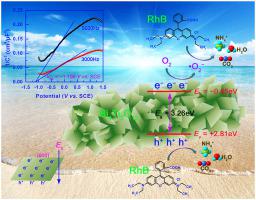Optical Materials ( IF 3.9 ) Pub Date : 2021-01-04 , DOI: 10.1016/j.optmat.2020.110781 Tingting Cheng , Xiaofeng Sun , Tao Xian , Zao Yi , Ruishan Li , Xiangxian Wang , Hua Yang

|
Herein we report the morphology tailoring of hierarchical Bi4Ti3O12 architectures by using tert-butylamine (TB) and oleic acid (OA). It is demonstrated that the content of TB and OA has an important effect on the morphologies of as-derived Bi4Ti3O12 samples. When adding 12 mmol TB and 6 mmol OA (with respect to 1 mmol Bi4Ti3O12) to the precursor solution, rod-like hierarchical architectures (length 2–15 μm, diameter 0.5–1.7 μm) are obtained. The hierarchical microrods are composed of nanosheets of 20–50 nm in thickness and 300–1700 nm in diameter. The addition of other amounts of TB and OA results in the formation of nanoflake-assembled hierarchical hollow microspheres with size of several micrometres; however the sizes of the microspheres and their sub-nanoflakes depend on the TB/OA amounts. Rhodamine B (RhB), methyl orange (MO) and methylene blue (MB) aqueous solutions, as well as RhB/MO/MB mixture solution (simulated dye wastewater), were used to evaluate the photodegradation performances of the as-prepared Bi4Ti3O12 samples under simulated sunlight irradiation. It is demonstrated that the nanosheet-assembled hierarchical microrods possess a photodegradation activity preponderating over the other morphologies. Moreover, the photocatalytic experiments reveal an interesting photodegradation process of RhB/MO/MB in the mixture solution, which is different from the photodegradation of single dye solution. The photodegradation mechanism of the Bi4Ti3O12 photocatalysts was investigated and discussed.
中文翻译:

叔丁胺/油酸辅助的Bi 4 Ti 3 O 12体系结构的形态学修整及其在模拟染料废水的光降解中的应用
在这里,我们报告通过使用叔丁胺(TB)和油酸(OA)的Bi 4 Ti 3 O 12分层结构的形态学剪裁。结果表明,TB和OA的含量对Bi 4 Ti 3 O 12样品的形貌有重要影响。当添加12 mmol TB和6 mmol OA(相对于1 mmol Bi 4 Ti 3 O 12)到前体溶液,获得了棒状的分层结构(长度2–15μm,直径0.5–1.7μm)。分层的微棒由厚度为20–50 nm的纳米片和直径为300–1700 nm的纳米片组成。添加其他数量的TB和OA导致形成纳米片组装的分级中空微球,其大小为几微米。但是,微球及其亚纳米颗粒的大小取决于TB / OA量。罗丹明B(RhB),甲基橙(MO)和亚甲基蓝(MB)水溶液以及RhB / MO / MB混合溶液(模拟染料废水)用于评估制备的Bi 4的光降解性能钛3 O 12样品在模拟阳光照射下。结果表明,纳米片组装的分层微棒具有优于其他形态的光降解活性。此外,光催化实验揭示了混合溶液中RhB / MO / MB的有趣的光降解过程,这与单一染料溶液的光降解不同。研究并讨论了Bi 4 Ti 3 O 12光催化剂的光降解机理。


























 京公网安备 11010802027423号
京公网安备 11010802027423号